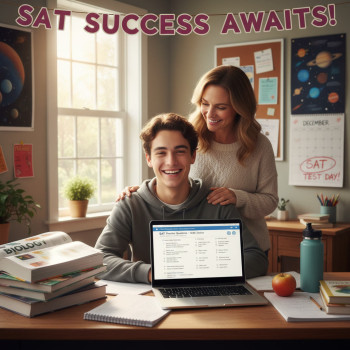Understanding the University of Utah’s SAT Landscape — What You Need to Know
If you’re a student (or a parent of one) planning to apply to the University of Utah, the SAT is likely on your radar. Over the last few years colleges have shifted policies — some went test-optional temporarily and many institutions now have nuanced approaches to SAT scores. The University of Utah considers SAT scores if you submit them, and understanding how they fit into the broader admissions puzzle will give you a real advantage when putting together a competitive application.

What the numbers look like
Admissions offices rarely publish a single cutoff score. Instead, they provide score ranges that represent the middle 50% of admitted students — which is a great place to start when setting your target score. For the University of Utah, the typical SAT range for admitted students centers roughly between the low 1200s and the mid 1300s (out of 1600). That means:
- Students near or above the upper end of this range will be comfortably competitive for general admission.
- Students below the lower bound can still be admitted — especially if they bring strong grades, extracurriculars, essays, letters of recommendation, or special circumstances.
Test-Optional vs. Test-Considered: How the University of Utah treats SATs
The University of Utah currently uses a considered-if-submitted approach. In practice, that means:
- If you submit SAT scores, the admissions team will review them alongside your high school GPA, course rigor, essays, and other materials.
- If you do not submit scores, admissions will evaluate you based on the rest of your file. Not sending a score does not automatically harm your chances — but it removes a potentially helpful data point.
Translation for strategy: submit scores if they strengthen your application. If your SAT is above or near the mid 1200s — especially if combined with a strong GPA — it’s often beneficial to send it. If your score is well below your other achievements, you may choose to withhold it and emphasize what you do best.
How Admissions Uses SAT Scores: A Practical Look
SAT scores don’t exist in a vacuum. They are one piece — sometimes an important one — in a holistic review. Admissions officers at public research institutions like the University of Utah typically weigh:
- High school GPA and course rigor (AP/IB/honors coursework)
- SAT or ACT scores (if provided)
- Personal statement and short-answer responses
- Extracurricular involvement, leadership, and awards
- Contextual factors such as school profile, family background, and life challenges
So: a strong SAT can boost an application, but so can steady improvement in grades, meaningful extracurriculars, and an authentic personal statement. The SAT is a tool — one that complements everything else you bring to the table.
Why the digital SAT matters now
The SAT transitioned to a digital format, which changes some test-taking dynamics: shorter test sessions, adaptive sections, and a different pacing cadence. Students who prepare specifically for the digital format — practicing on digital platforms, simulating the adaptive behavior, and refining time management — often see the benefits reflected in their scores.
Setting a Target Score: Aim Smart, Not Just High
It’s tempting to pick a lofty goal and sprint toward it. But a strategic target is one that balances ambition with realism. For the University of Utah:
- Reach goal: Aim for the upper half of the range (mid–high 1300s). That gives you leverage for scholarships and competitive majors.
- Solid goal: If you’re in the 1200–1300 range, you’re in the ballpark for many programs — focus on other strengths to stand out.
- Improvement goal: If current mock tests are below 1200, concentrate on steady, measurable improvement rather than quick fixes.
Real example: A student with a 3.9 GPA and a 1220 SAT can still be very competitive; their strong grades and AP classes signal academic readiness. Conversely, a student with a 3.4 GPA but a 1380 SAT may need to highlight upward grade trends and impactful extracurriculars to reinforce academic reliability.
How to use score range data in your application strategy
Score ranges help you prioritize: if your SAT is above the median, be sure to submit it. If it’s below but improving — for example, already trending upward across practice tests — you might retest or present other evidence of academic strength (AP scores, dual-enrollment transcripts, or teacher recommendations).
Timeline: When to Take the Digital SAT and Why
Timing matters. Pick SAT dates that give you time to prepare, retake if needed, and still meet application deadlines. Here’s a straightforward timeline suggestion for a typical high school junior-senior path:
| When | Action | Why it helps |
|---|---|---|
| Spring of junior year | Take the digital SAT (practice-tested) | Gives baseline and time for targeted prep |
| Summer after junior year | Focused prep and diagnostic work (digital practice) | Large improvement window without school pressures |
| Fall of senior year (early test date) | Official test — first real attempt for applications | Allows time for a retake if needed |
| Late fall / early winter of senior year | Retake if needed | Last chance to send improved scores before most deadlines |
Note: The University of Utah’s regular application deadline often falls in early April, with an earlier early-action deadline in December. Make sure your final SAT attempt finishes with enough time to receive and, if desired, send scores before those dates.
Prep Strategies That Work — Beyond Cramming
Quality preparation beats quantity. Focus on targeted, consistent practice and smart review:
- Diagnose: Start with a full-length digital practice test to find your strengths and weakest areas.
- Plan: Build a weekly schedule focused on those weak areas, while maintaining strengths.
- Simulate: Practice with the digital interface and time constraints to build stamina and familiarity with adaptive question behavior.
- Review: After every practice test, review every mistake in depth — understanding why the correct answer is right is crucial.
- Balance: Keep a steady schoolwork routine; colleges value strong grades as much as test scores.
Sometimes a personalized, 1-on-1 approach can accelerate progress. Sparkl’s personalized tutoring offers tailored study plans and expert tutors who can craft lessons around your diagnostic gaps and learning style, helping you focus your time efficiently. That kind of targeted help is often the difference between a small score bump and a meaningful breakthrough.
Practice examples that help most
- Timed, section-specific drills for the adaptive digital format.
- Vocabulary-in-context exercises and sentence-logic practice for evidence-based reading and writing.
- Targeted math concept blocks (algebra, problem solving, data analysis) with scaffolded practice.
- Full digital practice tests every 4–6 weeks to measure improvement and refine timing.
Putting the Application Together: Where SAT Fits In
When you submit your application, think of the SAT as one piece of a mosaic. Here’s how to present a cohesive picture:
- Academics first: Demonstrate consistent course rigor and improvement. AP, IB, and dual-enrollment courses are especially persuasive.
- Signal interest: Thoughtful short answers and your main personal statement should explain why the University of Utah suits your academic and personal goals.
- Context matters: Use the activities section to highlight depth and leadership — a long list of shallow involvements is less powerful than fewer, meaningful commitments.
- Supplemental evidence: If your SAT is a standout metric, submit it. If not, lean into your transcript and recommendations.
Admissions officers value clarity. When your SAT score aligns with other indicators (GPA and coursework), it reinforces your academic story. If there’s a mismatch — excellent grades but low SAT — use your essays or an additional note to explain any test-day issues or articulate your academic readiness through other measures (like AP scores or college coursework).
Scholarships and SATs: Why Scores Still Matter for Funding
Many scholarship programs — institutional or external — take test scores into account. A stronger SAT can open doors to merit-based awards. If scholarships are a priority, focus on hitting or exceeding the scholarship cutoff thresholds, and be sure to submit scores when they help your financial picture.
Sample scholarship strategy table
| Financial Goal | Role of SAT | Your Action |
|---|---|---|
| Maximize merit aid | Often requires scores near or above the higher end of admitted range | Retake once or twice with focused prep if you’re close |
| Supplemental scholarships | Some awards use SAT plus GPA and activities | Polish essays and submit SAT if strong |
| Need-based aid | SAT less relevant; FAFSA and CSS profile matter | Complete financial aid forms early |
Application Day Realities: What Students and Parents Ask Most
Here are common concerns and concise answers to guide decisions:
- Will a non-submitted SAT ruin chances? No — admissions will still evaluate the rest of your file.
- If my SAT is lower than my GPA suggests, should I submit? Not necessarily. Think holistically: if the score is an outlier and the rest of your portfolio is strong, you might skip it.
- How many times should I take the SAT? Twice is common: an initial test plus a targeted retake. Beyond that, only continue if you see meaningful improvement after focused prep.
The parent’s role
Parents are invaluable guides: help manage deadlines, encourage consistent study habits, and create a low-stress testing environment. Practical support — covering registration fees (if possible), arranging quiet practice space, or helping coordinate tutoring sessions like Sparkl’s personalized 1-on-1 plans — can make a big difference.

Realistic Case Studies: Stories That Teach
Case 1 — Emily: GPA 3.85, SAT 1240. Emily submitted her score and leaned into two things: a portfolio of leadership roles and a compelling essay about community health research. The admissions team saw consistent academic rigor and community impact, leading to admission into a strong major.
Case 2 — Noah: GPA 3.5, SAT 1380. Noah’s high SAT helped him stand out for a competitive engineering track. He used Sparkl’s targeted math tutoring to shore up problem-solving strategies and improve his timing — the tailored sessions focused exactly on the types of questions that appeared on the digital SAT.
Takeaway: There’s no one path. Students with different profiles can all find success by telling a clear story and using the SAT to complement — not replace — their academic record.
Final Checklist Before You Apply
- Confirm deadlines: Early action vs. regular — know the dates and leave buffer time for scores to arrive.
- Decide whether to submit scores: Compare your score against the mid 50% range and your overall profile.
- Complete a full digital practice test under test-like conditions at least once a month during peak prep.
- Review financial aid deadlines and scholarship timelines — some awards require test scores.
- Consider targeted tutoring: if you want a tailored plan, expert tutors, and AI-informed practice cycles, platforms like Sparkl offer 1-on-1 guidance that can tighten your study plan and accelerate improvement.
Closing Encouragement: You’re More Than a Number
Applying to the University of Utah is about demonstrating fit, curiosity, and readiness. The SAT is a tool that can strengthen your voice in the application, but it doesn’t define your potential. Stick to a clear preparation plan, focus on the parts of your application you can control, and use resources strategically — whether that’s a disciplined self-study plan, a supportive teacher, or personalized tutoring that adapts to your needs.
Remember: progress beats perfection. A steady plan, realistic goals, and concrete support will carry you further than last-minute cramming. The University of Utah values students who show consistent effort, intellectual curiosity, and meaningful engagement — make sure your application tells that story.
Need help building a prep plan?
If you want a partner in building a realistic, measurable SAT plan — from diagnostic testing to a final retake strategy — consider personalized tutoring options. A tailored approach gives you one-on-one attention, a study plan that fits your life, and adaptive insights so every hour you spend practicing moves you closer to your target. For many students, that guidance is the most efficient route to a meaningful score improvement and a calmer application season.
Good luck — and remember, whether it’s the SAT or the rest of your application, consistent effort, thoughtful choices, and authentic storytelling will shine through.


















No Comments
Leave a comment Cancel